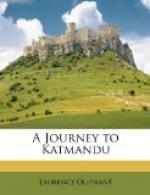The fact of the glass being thus pointed to his house was in itself a suspicious circumstance, but I little thought that the bland owner of the leaden spoons and pothouse pictures was then deliberately contemplating the vile plot he so soon afterwards nearly succeeded in executing. Within a week after this visit I heard that our polite entertainer was in confinement for an attempt to assassinate the minister, towards whom he had so recently professed the profoundest sentiments of regard.
We descended into the well laid-out garden attached to the palace and devoured the delicious mandarin oranges, with which hundreds of trees were loaded, until our attention was diverted from them by a luscious fruit, in appearance something like a medlar: this fruit is rare in Nepaul, the tree being a native of Thibet.
It cost us an effort to bid adieu to the polite prince and his attractive garden; but at length we remounted our elephants and proceeded on our way to the Minister’s house. Passing through the handsome gateway, guarded by a magnificent tiger, that prowled restlessly up and down his cage, a vigilant-looking sentinel, we entered a yard filled with the soldiers and retainers of the illustrious man whom we had come to visit.
We were greeted cordially by the Minister Sahib, who was surrounded by a crowd of brothers, only three of whom I knew, viz. the two fat travellers and the future would-be assassin.
Jung’s house was a large white building, which looked as if a Chinaman had mixed together a Birmingham factory and an Italian villa, every now and then throwing in a strong dash of the style of his own country by way of improvement. It is three stories high, and one wing is devoted to the six “beautiful missises” who compose the female part of his establishment.
The state-room was very similar in shape and appearance to that in the palace of the Mahila Sahib, but was, if possible, still more fantastically ornamented. A picture of her Majesty’s Coronation was supported on the one side by a lady’s bonnet, on the other by a carpet-bag, while a lady’s riding-habit, an officer’s red jacket, and various other articles of attire were hung round the walls upon pegs; here and there, perhaps partly hidden by the folds of a lady’s dress, was to be seen the portrait of some sedate old Nepaulese noble.
Jung called our attention to one of these; it was the portrait of a strikingly handsome man, whose keen eye and lofty brow seemed almost to entitle him to the position he held between the Duke of Wellington and the Queen. “See,” said Jung, enthusiastically, “here is the Queen of England; and she has not got a more loyal subject than I am.” Then turning to the picture of the man with the keen eyes and high forehead, he remarked, “That is my poor uncle Mahtiber Singh, whom I shot; it is very like him.” After which he launched into a discussion upon the comparative merits of the Duke of Wellington and Napoleon, and, skipping two cocked hats and a bonnet, went on to some Purdy’s rifles, of which he spoke in glowing terms and with all the enthusiasm of a true sportsman.




